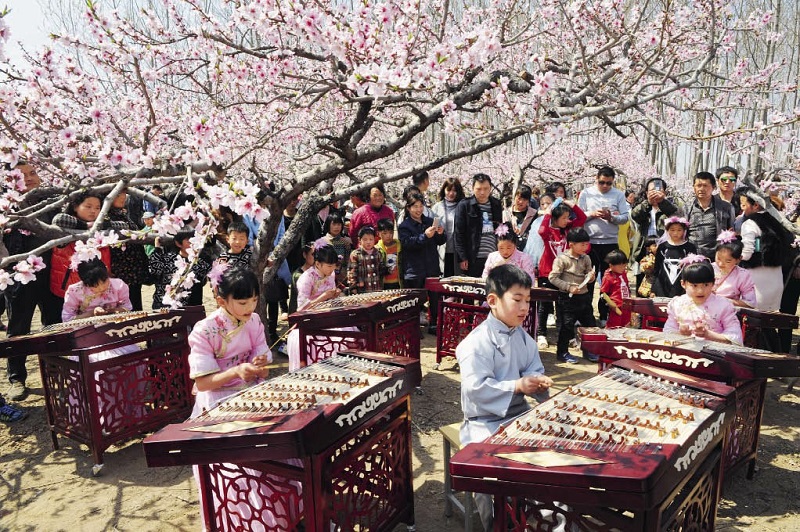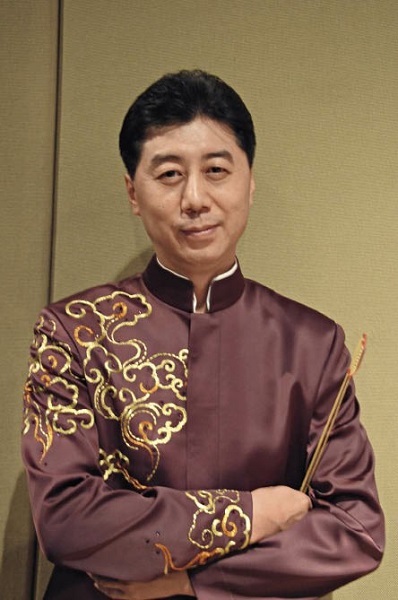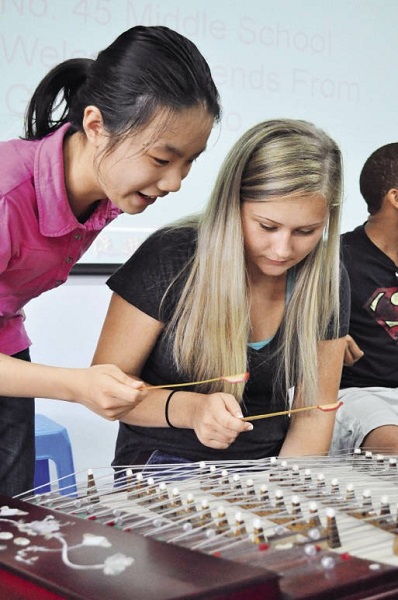“It is widely recognized that the piano is a variant instrument of China’s yangqin, one major difference being that the hammers and strings of the piano are placed inside the instrument body instead of outside like the yangqin,” said the Minzu University professor Xu Xuedong, a yangqin virtuoso and composer. “Consequently, the yangqin is also known as the ‘Chinese piano.’”
Today, the yangqin and its foreign “counterparts” are called by different names in various countries, but it is generally known by its English name hammered dulcimer. Xu adds, “The yangqin is the only musical instrument that has similar versions of it being played in more than 60 countries.”
Though they all trace their early roots back to the region of Iran, the shape, structure, and playing methods of each member of the hammered dulcimer family significantly differ from country to country. For instance, in terms of appearance, the yangqin is much larger than the santur in India while much smaller than the hammered dulcimer in Romania. With reforms to adapt to Chinese culture, the yangqin has gradually evolved into an independent Chinese instrument, markedly distinct from those hammered dulcimers outside China. The yangqin is not only popular in China, but also widely played by people in Korea, Japan, and Southeast Asian countries.

On March 27, 2016, a group of primary school students perform classic Chinese music on yangqin in a peach orchard in Wuma Town, Qiaocheng District of Bozhou City in Anhui Province.
Integrating into Native Culture
According to historical records, during the reign of Emperor Wanli (1573-1620) in the late Ming Dynasty (1368-1644), the yangqin first came into China via the Maritime Silk Road. It arrived in Guangdong Province and then spread to other inland regions including provinces of Guangxi, Sichuan, and Hunan.
When it came to the late Ming Dynasty, the rise of Chinese folk opera art along with the increasing popularity of Chinese novels bolstered a rapid integration of the yangqin with local folk instruments, giving birth to a new form of orchestra and adding a new charm to Chinese folk art. By late Qing Dynasty (1644-1911), the yangqin had become an essential part of nearly all Chinese folk operas for various ethnic groups across China. For example, the yangqin has been the main accompaniment instrument in the orchestra of the folk opera form Qinshu, which has different local versions like Sichuan Qinshu and Shandong Qinshu. In Beijing Qinshu, sanxian (a Chinese stringed instrument) and yangqin are the only instruments used in the orchestra.
Throughout the development history of yangqin in China, it has undergone several major changes. The original yangqin was played with wooden hammers. Chinese people opt for bamboo hammers because bamboo exhibits better natural elasticity. “Bamboo is bouncy,” explained Xu, “and the bamboo hammers bounce back easier once they strike the board.” He also believes that the reason why Chinese people in the past chose bamboo hammers rather than wood hammers was that bamboo represented the spirit of Chinese literati. There is much truth to this statement as in Chinese culture, bamboo is the personification of a number of admirable traits, for example an unyielding spirit. Different choices of striking material mark a key difference between Chinese yangqin and Western hammered dulcimers.

Xu Xuedong, a yangqin virtuoso and composer.
More Octaves and Strings, a Test for Tuners
During the 400 years since the yangqin was brought to China, few modifications had been made to the modulation mechanism of the musical instrument, until in the 1960s after the founding of the People’s Republic of China. Ancient yangqins only had a range of two and a half octaves. But in the early 1970s, the modulating yangqins with four sets of frets was invented, increasing its music range to four and half octaves. Now some yangqin can span five and a half octaves.
Among all existing Chinese musical instruments, owing to its broadest spectrum and highest number of strings, the yangqin also has the most complicated modulation mechanism. “A person who could tune a piano may not be able to tune a yangqin,” says Xu, “because yangqins have so many strings and they often get loose.” Those strings that produce mid and high range tones are normally made of steel. Decades ago, strings that were used to make mid and low pitch tones were made of bronze, but now they are replaced with strings made of silver, able to produce a deeper and louder sound.
Considering the rather large number of strings that yangqin instruments have, their production requires a typical type of wood that is hard enough to withstand the pressure made by over 100 steel strings. The upper board is made of paulownia, a soft wood that is conducive to producing a superb sound. The entire structure of the yangqin can endure four tons of force, the equivalent of the force of a truck. Thus, the body of a yangqin is made of a very hard wood called painted maple, which grows in cold areas around China’s northeast and Russia. The maple wood which is used for producing yangqin need to be at least 100 years old, having a high level of density and not prone to crack or break.
A Conductor Who Can Now Go Solo
“Its broad musical range and up-down hammering movements are the key features contributing to its incredible compatibility with various forms of opera performances,” Xu explained. With its broad musical range of 144 strings, yangqin can fit nearly all types of music. Both hands move up and down in the air, making it easier to be seen and followed by other orchestra players. Thus, in an orchestra performance, yangqin naturally serves the role of controlling and maintaining the rhythm and the pace of a song as well as directing the whole band while rendering the music piece.
Though yangqins are usually used to accompany other instruments like erhu (a classical Chinese stringed instrument), not serving as a leading role on the stage, yangqin performers never complain but enjoy their supporting role. “Besides, when performing together, I can learn from other instrument performers about their understanding of the music and their methods of controlling rhythm and melody. Chinese philosophy can be found everywhere,” said Xu, “as Confucius put it, when three are walking together, I am sure to find teachers among them.”
Today, a yangqin band has emerged consisting of low-, mid- and high-pitch yangqins. Xu is very glad to see this historic breakthrough. “The yangqin family expanded. Now it can be played as a solo instrument and perform more extensive and abundant tunes for the audience.”

An American middle school student is learning to play yangqin from a Chinese student at Hefei No. 45 Middle School of Anhui Province.
Still Popular in the Modern Era
China has the largest population of yangqin players, larger than that of all other countries combined. “It is estimated that, in China’s mainland, there are 50,000 professional yangqin performers and 400,000 people who are learning to play the musical instrument,” says Xu.
In 2012, the first yangqin festival was held in Hangzhou, featuring competitions, concerts, and expert seminars with 550 participants from China and other countries. The number of participants grew steadily each year from 550 in 2012 to 800, 1,300, and over 2,000 in 2014, 2016, and 2018 respectively. In China, yangqin has been included in the music course of elementary school, middle school, high school, and higher education institutions. Today, over 100 universities in China have majors in yangqin, including doctorate degrees.
China is also taking an active part in enhancing communication and exchanges about the musical instrument with other countries that are home to hammered dulcimers. China hosted the Hammered Dulcimer World Congress in 2005 and 2019, a platform aiming to support and promote hammered dulcimer music in the world.
In 2001, the China Ethnic Orchestra Society was established and 5,000 yangqin players registered as members of the society. In 2004, under the guidance of this society, a team of yangqin experts began to compile a large collection of yangqin songs. “It was a big project,” Xu remarked, and continued to say, “We reviewed thousands of old records and books which contained old yangqin music scores covering a period from the late Qing Dynasty to modern era.” A total of 1,100 pieces of yangqin music were eventually found, and 106 pieces of those were included in the collection. “We hope those beautiful tunes can be written down and passed on to future generations.”